Geography fun facts and oddities
Geography fun facts & oddities
- collection of geography facts, oddities and extremes
- see also:
- Geography bee
- Geography vocabulary
- page organization t.b.d.
Physical geography fun facts[edit | edit source]
- Pitcaren Islands in Polynesia, are the least populated political entity in the world (67 residents)
- Vatican City, for example, has 825 residents
- Rio de la Plata is the widest river in the world (max width: 140 mi)
- the Rio de la Plata is considered a river, estuary, gulf or "marginal sea"
- it is fed by the Uruguay and Parana rivers at Punta Gorda ("fat point"
Physical geography oddities[edit | edit source]
Earthquakes[edit | edit source]

- 5-largest recorded earthquakes by magnitude:
- [9.4-9.5 1960 Valdivia earthquake, Chile]
- [9.2 1964 Alaska earthquake (wiki)]
- [9.1-9.3 2004 Indonesian earthquake (wiki)]
- [9.1 2011 Dhoku, Japan earthquake & tsunami (wiki)]
- [9.1-9.3 1730 Valparaiso, Chile earthquake (wiki)]
- see Tsunami section below for the 2004 Indian Ocean earthquake and tsunami
- 2011 Virginia earthquake
click EXPAND for details & video from top of the Washington Monument
- this 5.8 magnitude earthquake, centered in Louisa County, Virginia, was felt as far as New England, Canada, Michigan and Alabama and Florida
- the reason the tremors were so widely felt is that the U.S. East Coast has extensive bedrock that transmits shock waves across extensive distances, whereas less geologically stable areas do not transmit shock waves as far.
- See
- [Earthquake at the Washington Monument (NPS.gov)]
- [Virginia earthquake, 2011 (wiki)]
Mountains[edit | edit source]

- Kirkjufell, Iceland
- a mountain formed of volcanic rock, but not itself a volcano
- during Ice Age was a "nunatak" = a landform protruding above glaciers
- it's unique spiraling forms were shaped by glaciers
- known for it serene waters which reflect the mountain and beautiful seasonal waterfalls (thus the name)
- was location for two seasons of "Game of Thrones" series
https://en.wikipedia.org/wiki/Kirkjufell
Volcanos[edit | edit source]
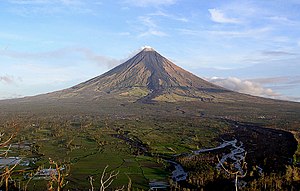
- Mt. Mayon, Philippines
- a stratovolcano that has a near-perfectly symmetric, or "perfect", cone
- = the most active volcano in the Philippines
- traditionally worshipped
- see https://en.wikipedia.org/wiki/Mayon

- Cueva de los Verdes ("the cave of Verdes")
- world's longest "lava tube" was created 3,000 years ago by the eruption of Monte Corona, Canary Islands
- lava tubes are formed when a lava stream cools and solidifies at the top, while lava below continues to flow, leaving a cave after full draining.
- the cave is 3.7 miles long on land and extends another 0.93 miles under water
- see Cueva de los Verdes (wikipedia)
- April's Fool volcano prank
- on April 1, 1974, pranksters climbed atop the dormant 3002 ft high volcano, Mt. Edgecumbe, near Sitka, Alaska
- a helicopter had dropped off old tires, kerosene, smoke bombs and rags, which the pranksters lit and threw into the crater
- a Coast Guard helicopter was dispatched to observe the eruption and instead saw a man standing by spray-painted show reading, "APRIL FOOL."
- see https://www.iflscience.com/environment/the-greatest-april-fools-day-prank-of-all-time-took-four-years-to-plan-and-involved-a-volcano/ Greatest April Fools Day Prank of All Time (iflscience.com)]
Rocks[edit | edit source]
Famous rocks[edit | edit source]
- Devil's Tower

- click EXPAND for details on Devil's Tower
- a butte formation in Wyoming that abruptly juts out of the landscape 1,267 ft high
- the name comes from an English misinterpretation of the Native American name for it
- the native name is "bear's house" (among others) and was understood in English by a US Army expedition leader as "Bad God's Tower," thus "Devil's Tower"
- a Native American legend of its origin is that young girls where chased by bears, and their prayers for salvation were answered by the "Great Spirit" by lifting the rock they sat upon into the air, out of reach from the bears, whose claws scratched marks into the sides of the rock while trying to reach them.
- See [Devil's Tower (wiki)]
- Independence Rock

- famous for unique formation and 19th century graffiti
- click EXPAND for details and more images of Independence Rock


- a 130 ft high granite rock in Wyoming that sticks up out of the prairie
- located at the southeast end of the Granite Mountains
- served as a landmark for 19th century western settlers, some of whom carved their names on the rock and some of which are still visible
- Pompy's Tower" (Pompey's Pillar National Monument)
- famous for inscription by William Clark from 1806
- click EXPAND for details and image of Pompey's Pillar

- rock formation rising from the Montana plain
- 150 ft tall, located near the Yellowstone River
- one of the smallest National Monuments in the US (21 acre site)
- famous for its graffiti:
- William Clark, of the Lewis & Clark Expedition (1803-06) inscribed his name on the rock on July 25, 1806

- Clark's journal entry of that day:
“This rock which I shall Call Pompy's Tower is 200 feet high and 400 paces in secumphrance… The nativs have ingraved on the face of this rock the figures of animals &c. near which I marked my name and the day of the month & year.”
- Three Sisters or Three Sisters Islands
- click EXPAND for image, details and info on & legends behind the name of the rocks:

- three rocky islands in the Potomac River in Washington, DC
- three Native American sisters who died crossing the river there while trying to rescue their brothers who had been kidnapped by another tribe
- three Native American sisters who were banished to the islands after refusing the husbands selected for them by their father; the sisters cursed the spot, which is said to make an eerie sound whenever the River is about to take a life
- a 1925 novel included a story about three nuns who drowned at the spot
- three rocky islands in the Potomac River in Washington, DC
See: [Three Sisters (wiki)]
Glacial erratic rocks[edit | edit source]

- rocks that are moved to one place from another by glaciers
- and that are dissimilar (not like) the rocks where they are found
- Madison Boulder
- 83 ft long, 23 ft high and 37 feet wide
- the largest "glacial erratic" rock in North America
- one of the largest in the world
- it is of granite, while there is no other granite nearby
- thereby, we can know it was moved to that location by glaciers
click EXPAND for more images of glacial erratic rocks




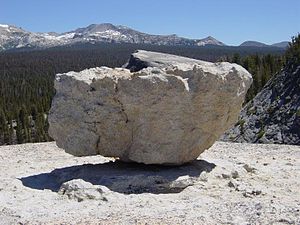

see
- https://www.nhstateparks.org/visit/state-parks/madison-boulder-natural-area
- https://en.wikipedia.org/wiki/Glacial_erratic
Sinkholes[edit | edit source]

- sinkholes are holes or caves in the ground caused by erosion or a collapse of a lower, below-ground surface, usually because of water drainage
- sinkholes may also be caused by a drainage of water, such as a water table decline
- sinkholes are most common where limestone, sandstone, salt beds, or gypsum are prevalent
- Thor's Well
- a sinkhole on the coast of Cape Perpetua, Oregon, that drains at high tides
- Golly Hole in Alabama is considered the largest sinkhole in the US.
Click EXPAND for image and details on Golly Hole

- also known as the "December Giant," it formed in 1972 after water drainage at a nearby quarry,
- it is 325 ft long, 300 ft wide, and 120 ft deep
- source: [What is the largest sinkhole in the United States? (usgs.gov)]
- For more on sinkholes:
Tsunamis[edit | edit source]
- series of large waves caused by earthquakes, volcanic eruptions, landslides, glacier breaks, or meteorites
- also known as "tidal waves," although tsunamis are not tides
- see File:NOAA Tsunami Animation-2016.webm for tsunami animation
- or here [NOAA Tsunami channel] or [NOAA Model Animations]
- Lituya Bay, Alaska, 1957
- a narrow inlet, earthquake-induced tsunami waves reached 1,720 feet high
- see [1958 Lituya Bay, Alaska earthquake and megatsunami was the highest recorded Tsunami (wiki)]
- 2004 Indian Ocean earthquake and tsunami
- 9.1 magnitude earthquake caused a 900-mile fault line between the Indian and Burnma tectonic plates
- as a result of the shift, the ocean floor rose upwards 10 feet, trigging up to 100-foot high tsunamis that spread across the entire Indian Ocean
- occurred on Dec 26, 2004, so is also known as the "Christmas" or "Boxing Day" earthquake and tsunami
click on EXPAND for more on the 2004 Indian Ocean earthquake and tsunami
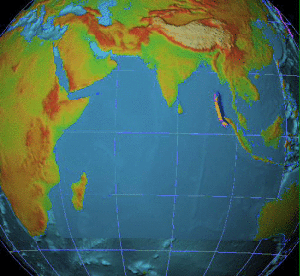

- the earthquake was the 3rd-largest and single longest (8-10 minutes) ever recorded
- it triggered other earthquakes around the world
- the epicenter of the quake was 100 miles off the coast of Sumatra (the largest island of Indonesia)
- the Indian Ocean floor rise was permanent and consequently the world's entire ocean surface rose by 0.004 inches
- 227,898 people were killed by the tsunami
- the Indonesian cities of Banda Aceh and Lhoknga, at the northwest corner of Sumatra, were completely destroyed
- 167,000 people were killed in Banda Aceh and over 7,000 people in Lhoknga
- the largest waves to hit Lhoknga were 98 ft high
- the Indonesian cities of Banda Aceh and Lhoknga, at the northwest corner of Sumatra, were completely destroyed

- a large ship was carried almost 2 miles inland (and remains there as a memorial)

- tsunami waves reached Sri Lanka, 1,100 miles away, two hours after the quake, killing approx. 35,000 people
- almost 8,000 people were killed in Thailand, 500 miles away
- the waves extended across the Indian Ocean, hitting India, Madagascar and the African mainland
- sources:
Name origins (etymology) and unusual or odd names[edit | edit source]
- etymology is the study of the origin of words
Country names[edit | edit source]
- Literal Meanings of Country Names map
- a credit card travel service in Australia created a world map showing the "literal translation" of names of every country
- the original website is a sales site here: [https://finty.com/au/research/world-map-literal-translation-country-names/ (finty.com)]
- downloads for the world map and separate continents can be found at the bottom of that page
- here for the [direct link to the world map (finty.com)]
- here for articles on the map [Mapped: The Literal Translation of Every Country’s Name (VisualCapitalist.com)] or https://www.lonelyplanet.com/articles/map-literal-translation-country-names This map shows you the literal translation of country names (LonelyPlanet.com
- here [a web-based spreadsheet with details of the word origins (etymology)] from the makers of the map
America[edit | edit source]

- America is named for the Italian explorer and map-maker Amerigo Vespucci
- Vespucci was the first European explorer to recognize that the lands Christopher Columbus discovered were distinct regions from Asia
Click EXPAND for more on Vespucci and the Waldseemüller map which labeled part of the "new world" as "America"
- Vespucci was from Florence and went on two expeditions to the Americas in 1499 (for Spain) and 1501 (for Portugal)
- in 1503 and 1505 two accounts of his voyages were published using his name
- his authorship and many of the details in them is doubted by historians
- the booklets were wildly popular across Europe
- Vespucci's accounts were the first to consider the Americas as distinct from Asia (Columbus insisted he had reached the "Indies")
- Vespucci referred to Brazil, which he visited on his second voyage, as the "New World"
- in 1507, the German cartographer (map maker) Martin Waldseemüller labeled "America" on a portion of his world map
- he credited Amerigo Vespucci for the insight
- the map was the first to show the Americas as distinct continents from Asia
- see
Central America[edit | edit source]
- Yucatan
- Yucatan peninsula was named by the Spanish
- theories of the origins of the name
- when the Spanish arrived there, they asked the local Maya then name of the place and when the Maya replied that they didn't understand them, the Spanish thought that was the name of the place
click EXPAND for more details
- the Maya replied either "Ma'anaatik ka t'ann" which means "I do not understand you" or "uh yu ka t'ann," which means "hear how they talk!"
- the Spanish thought they said "Yucatan," so called it that
- the other theory is that the Maya extensively cultivated "yucca" plants (or "cassava," a tuber, similar to sweet potatoes) and so named the region for that practice
- it is possible, but the yucca plant and its name was common across all Maya regions
- also, Yucatan is the location of the " Chicxulub" asteroid that created the "Chicxulub crater"
- see: [Yucatan Etymology (wiki)]
Atlantic & Caribbean[edit | edit source]
- Antilles
- Canary Islands
- from the word "canine" for dogs that lived on the island
- Caribbean
- named for the Carib people that occupied southern portion of the Caribbean Sea
- the Taino people were the original inhabitants of the region, including the Bahamas
- Madeira
- Atlantic island 350 miles west of Morocco
- "madeira" means wood, as the islands had old-growth trees that the Portuguese used for ship building
click EXPAND for more on Madeira
- the ancient Greeks may have known of Madeira
- the Vikings probably visited it between 9330 and 1030 AD
- uninhabited when discovered in 1419 by a Portuguese vessel that was blown off course
- by 1500 Madeira was one of the largest sugar producers in the world and 10% of its population were African slaves
- Madeira is a Portuguese autonomous region (part of Portugal but self-governed)
British Islands[edit | edit source]
- Llanfairpwllgwyngyllgogerychwyrndrobwllllantysiliogogogoch
- original name of the Welsh village
changed its name in the 1860s from the shorter Llanfairpwllgwyngyll to increase its publicity. At 58 letters, it has the longest place name in the UK
Europe[edit | edit source]
Greenland & Iceland[edit | edit source]
Mid East[edit | edit source]
- Levant
- "the Levant" is a region consisting of the eastern coast of the Mediterranean Sea
- "levant" = French for "rising" or "risen"
- "levant" is the past participle (past tense verb used as an adjective) of the verb "lever" (to rise)
- = a reference to the sun rising from the eastern shores of the Mediterranean
Indus, India, Indonesia[edit | edit source]
- Indus is the name for the river that gives the name for India
- the Indus River is in Pakistan
- "indus" = indo-european word for "river
- "India" therefore is the "land of the River"
- "Indonesia" therefore "islands of India"
United States[edit | edit source]
- Accident, MD
- early settlement in western Maryland
- a competing survey of property "by accident" made a claim of the other's property
- people from Accident call themselves, "Accidentals"
- source: [Pictory History of Accident, Maryland, (WHILBR)]
- Lake Chargoggagoggmanchauggagoggchaubunagungamaugg
- located in Webster MA, anglicized spelling of original Native American name
- Telluride, Co
- named for the mineral "tellurium"
- located amidst the largest concentration of 14,000 ft mountains in the U.S.
- the apocryphal origin is that, due to the treacherous mountains, miners warned those who wanted to strike gold there, "To Hell You Ride!"
Political geography fun facts[edit | edit source]
- countries that have no capital
- Nauru
- an island nation in the Pacific Ocean, second smallest nation in the world
- Switzerland
- Bern is considered a "de facto" (in fact) capital, as it is the primary location for the national government, including the legislature and national courts
- however, the Swiss constitution does not stipulate (name) a capital, so de jure (in law) there is no capital
- the Swiss call Bern the "federal city"
- Bern is the 5th most populous city in Switzerland
- countries with multiple capitals and/or official seats of government
- some countries have official capitals
- others have an official capital and another city that serves as a prominent "seat" of the government
click EXPAND for a few countries with multiple capitals:
- Bolivia
- constitutional capital and seat judicial seat Sucre
- executive and legislative seat: La Paz
- Chile
- the official capital is Santiago
- the legislature is in Valparaiso
Honduras
- official capital: Comayagüela
- seat of government is in Tegucigalpa
- Netherlands
- the legal capital is Amsterdam, but the Hague is considered "the seat" of the government
- national administrative offices and the official workplace of the Dutch king, Noordeinde Palace, are located there
- South Africa
- three official capitals: Cape Town (legislative branch), Bloemfontein (judicial branch), and Pretoria (executive branch)
- official seat of government: Lobamba
- administrative capital: Mbabne
- for full list see [List of countries with multiple capitals (wiki)]
- see also: ** [Countries with two capitals (seterra.com)]
- Freaky little places:
- Andorra
- Faroe Islands
Political geography oddities[edit | edit source]
Enclaves & exclaves[edit | edit source]
- see: https://en.wikipedia.org/wiki/Enclave_and_exclave
- enclave = a country or territory that is entirely surrounded by another country or territory
- "enclave" is derived from the Latin inclavare for "to close with a key," meaning one property that is entirely surrounded by another property
- nation state enclaves:
- click on EXPAND to see list of nation state enclaves:
- Vatican City (within Italy)
- San Marino (within Italy)
- Losotho (within South Africa)
- note: these nations are not exclaves since they are not separated from a mainland territory
- click EXPAND for a list of semi-exclaves:
- semi-enclave states are surrounded by another state by land but also have a water border, such as:
- Monaco (surrounded by France and the Mediterranean Sea)
- The Gambia (surrounded by Senegal and the Atlantic Ocean)
- Brunei (surrounded by the Malaysian state, Sarawak and the South China Sea)
- Singapore (surrounded by Malaysia and the Strait of Singapore
- several other enclave states exist politically independent but are not recognized officially as independent nations
- exclave = a territory or part of a country that is separated from the main country or territory and surrounded by one other country
- click EXPAND for a list of exclaves:
- Madha (or "Wadi Madha"), territory of Oman, is located entirely within by Nahwa, part of the United Arab Emirates (UAE)
- Nahwa, territory of the Emirate of Sharjah (part of UAE), is itself an enclave within Oman
- Musandam is an associated exclave of Oman with Madha
- Llívia is territory of Spain that is within France.
- Campione d'Italia, territory of Italy is within Switzerland.
- Büsingen am Hochrhein, territory of Germany is within Switzerland.
- Likoma and Chizumulu Islands in Lake Malawi are Malawi territory surrounded by Mozambique territorial waters.
- exclave within multiple nations:
- Nakhchivan, separated territory of Azerbaijan, is surrounded by Armenia, Turkey and Iran
- United Arab Emirates (UAE)
- is made up of seven "emirates," partly independent states that together form the nation of the UAE
- of these, Dubai (exclave: Hatta), Ajman (exclaves: Masfout & Manama), Ras al-Khaimah and Sharjah have exclaves that are surrounded by another nation:
- Ras al-Khaimah and Sharjah (and Nahwa which is also an enclave)
- semi-exclave = territory or part of a country that is separated from the main country or territory and surrounded by another country and a large body of water
- click EXPAND for a list of semi-exclaves:
- Kaliningrad Oblast: Russian exclave territory 200 miles from mainland Russia that is surrounded by Poland and the Baltic Sea
- Kaliningrad was allocated to the Soviet Union at the Potsdam Conference in 1945, which divided Europe between the allied powers at the end of World War II
- Crimea: "de jure" (legally) Ukraine territory that is occupied by Russia and is therefore a de facto (in fact) Russian semi-exclave surrounded by Ukraine and the Black Sea.
- click EXPAND for a list of U.S. semi-exclaves:
- Alaska is a semi-exclave in that it is separated from the main country and surrounded by another country (Canada) and by a large body of water (Bering Sea and the Pacific and Arctic Oceans)
- Alburgh, VT is on the Alburgh Tongue on the tip of a peninsula from Canada that extends into Lake Champlain
- Hyder, AK is located
- Hyder is Alaska's easternmost town and can only be reached by road by passing through Canada. Hyder is not technically an exclave, in that it is connected to Alaska, although it lies at the tip of a penninsula creaed by the Salmon River
- Point Roberts, WA is located at the southern tip of the Tsawwassen peninsula, Vancouver, Canada and can only be reached by land from the U.S. by going through Canada
- note: Hawaii is not technically an exclave, as it has no borders with another nation, although, as an island, it is separated from teh mainland U.S.
- some places that are both enclaves and exclaves
- not independent countries, but part of one country that are surrounded by another
- click EXPAND to see a list of some places that are both ENCLAVES & EXCLAVES
- Artsvashen, territory of Armenia, is within Azerbaijan
- Dahagram-Angarpota, territory of Bangladesh that is within India
- Baarle-Hertog, small territories of Belgium that are within the Netherlands
- Nahwa, territory of the Emirate of Sharjah (part of UAE), is itself an enclave within Oman
- For full list see: [Enclaves that are also exclaves (wiki)]
Landlocked countries[edit | edit source]
- = countries that have no coastal borders
- click EXPAND to see a list of some prominent landlocked countries:
- Afghanistan (South Asia)
- Austria (Europe)
- Ethiopia (Africa)
- Laos (Southeast Asia)
- Malawi (Africa)
- Mongolia (Asia)
- Paraguay (South America)
- Switzerland (Europe)
- Uganda (Africa)
- Double Landlocked countries
- = landlocked countries surrounded by landlocked countries
- click EXPAND to see a list of the only two double-landlocked countries:
- Liechtenstein
- Uzbekistan
Physical geography extremes[edit | edit source]
Highest, lowest extremes[edit | edit source]
- the deepest spot on earth is 7,169.3 ft lower than Mt. Everest is high
- Lowest spot on surface of the earth
- underwater:
- Mariana Trench
- underwater:
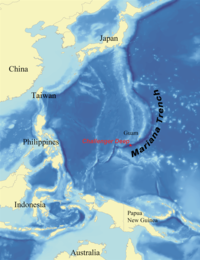
- located in the South Pacific Ocean, deepest landform on earth
- 1,580 mi long, 43 mi wide, max. depth 36,201 ft
- click EXPAND for more on the Mariana Trench and other trenches
- the lowest point is called "Challenger Deep"
- it has been reached by humans six times
- the 2nd deepest trench is the Tonga Trench in the Pacific with has max. depth of 35702 ft
- other trenches in the Pacific Ocean are nearly as deep, including the Philippine Trench and the Kuril-Kamchatka Trench

- the deepest trench in the Atlantic Ocean is the Puerto Rico Trench, which is 28,900 ft at its max. deep point
- lowest point on the land surface:
- the Dead Sea (Israel, Palestine & Jordan), 1419 ft below sea level
- 2nd lowest point on earth: Turfan Depression (China), 505 ft. below sea level
- this 2nd lowest point excludes other areas in the Dead Sea
- 3rd lowest point on earth: Lake Assal (Djibouti, part of the Afar Depression), 502 ft below sea level
- lowest point in US: Death Valley, 282 ft below sea level
- 2nd lowest point in US: Bombay Beach (California, along the Salton Sea, 226 ft below sea level
- click EXPAND for more on the Salton Sea
- the Salton Sea is a salt-water lake in Southern California at the Mexico border
- the Salton Sea has been fed by the Colorado River, which currently flows to the east of the lake, but in its modern form was created by diverter water from the river in 1900, which created the lake on dry lake bed.
- The Salton Sea is known as the fastest water for speedboat racing water in the world (see [Salton Sea#Powerboat racing (wiki)]
- the Salton Sea is a salt-water lake in Southern California at the Mexico border
- continent with the "highest lowest point": Europe
- the Caspian Depression, location of the Caspian Sea is 92 ft below sea level
- the lowest point in Europe is in the coastal area, Zuidplaspolder, in the Netherlands, which is 23 ft below sea level
- continent with the "highest lowest point": Europe
- deepest cave: Krubera Cave (Georgia - the nation): 7,188 ft deep
- highest mountain on earth: Mt Everest: 29,031.7 ft
- highest mountain outside of the Himalaya-Karakoram range: Mt. Tirich Mir (Pakistan), in the Hindu Kush
- highest mountain outside of Asia: Mt. Aconcagua (Argentina) 22,835 ft
- highest volcano: Mt. Ojos del Salado (Argentina & Chile), 22,615 ft
- tallest mountain from its base: Mt. Mauna Kea, Hawaii, has combined elevation of 33,480 from its base on the ocean floor
- lake
- highest lake: a water-filled crater on Mt. Ojos del Salado (Argentina & Chile), 22,615 ft
- highest "navigable" lake: Lake Titicaca (Bolivia & Peru), 12,507 ft
Political geography extremes[edit | edit source]
Largest & smallest nations, Highest & lowest populations[edit | edit source]
- click EXPAND for the answers
Africa
- largest country in Africa by territory:
- Algeria
- second & third largest countries in Africa by territory:
- 2nd: Democratic Republic of the Congo
- 3rd: Sudan
- smallest country in mainland Africa:
- The Gambia is the smallest country in mainland Africa
- it is also a semi-enclave surrounded by Senegal and the Atlantic Ocean
- smallest smallest country in Africa, including islands:
- Seychelles
highest population in Africa:
- Nigeria
2nd highest population in Africa:
- Ethiopia
lowest population in mainland Africa:
- Djibouti
lowest population in Africa among independent nations (territories excluded) and including island states:
- Seychelles
lowest population in Africa, including island states and semi-independent territories:
- Saint Helena
second lowest population in Africa, including island states and territories:
- Seychelles
Asia
Australia
- Australia is the largest and the smallest country in Australia
- Australia is the only country to entirely occupy a continent
Europe
- largest countries in Europe by territory
- smallest countries in Europe by territory
- 1
- 2
- 3
- Liechtenstein: 62 sq miles
- Liechtenstein has one of the highest per capital GDPs in the world
- largest countries in Europe by population
- Smallest countries in Europe by population
Directional extremes (north, south, east, west)[edit | edit source]
United States
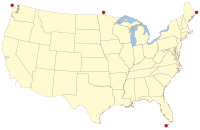
- easternmost point in continental U.S.: Sail Rock, Lubec, Maine
- northernmost state in the continental U.S.: Minnesota
- northernmost point in the continental U.S.: Northwest Angle, Minnesota, known as "The Angle"
- Click EXPAND to read more about the Northwest Angle:

- when negotiating the US-Canadian border following the American Revolution (Treaty of Paris, 1783), negotiators used an inaccurate map of the border of present-day Minnesota and Canada, and thereby included the northwest portion of the Lake of the Woods as the border, while it actually lies within Canadian territory
- thus The Angle is one of six "practical exclaves" of the U.S., as it is only accessible by land via Canada
- in 2010, it's population was 119
- see: Northwest Angle (wiki)
- northernmost point in U.S.: Point Barrow, Alaska
Economic Extremes[edit | edit source]
- richest country by overall GDP
- richest country by per capita GDP
- poorest country by overall GDP
- poorest country by per capital GDP
- most industrialized country
- most agriculture-based country (least industrialized)
- most
Demographic Extremes[edit | edit source]
- the only Hindu-dominant island in Indonesia
- Bali
- most homogenous country
- most diverse country
- most languages
- most dialects
Regional extremes
Resources & websites[edit | edit source]
Geography jokes[edit | edit source]
U.S. states names[edit | edit source]
- What did Tennessee?
- The same thing as Arkansas
- How did Florida?
- She died of Missouri
- What did Delaware?
- She wore a New Jersey"
- What's the newest state?
- Not sure, but Alaska!
- How did Wiscon-sin?
- He stole a Nebrask-y
Europe[edit | edit source]
- I had a cousin named Lorraine. And another named Alsace.
- They never did get along.
- Cry me a river
- Sorry, Crimea is a peninsula, not a river!